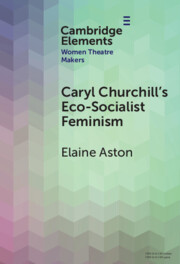Refine search
Actions for selected content:
510 results
7 - Critical Security Studies
- from Part I - Security in Theory
-
- Book:
- Understanding International Security
- Published online:
- 11 October 2025
- Print publication:
- 30 October 2025, pp 133-154
-
- Chapter
- Export citation
8 - Conflicts over Reproductive Rights since the 1980s
-
- Book:
- Population Control as a Human Right
- Published online:
- 09 October 2025
- Print publication:
- 23 October 2025, pp 158-183
-
- Chapter
- Export citation
Chapter 15 - Bloomsbury’s Gender Politics
- from Part III - Intimate Bloomsbury
-
-
- Book:
- A History of the Bloomsbury Group
- Published online:
- 09 October 2025
- Print publication:
- 23 October 2025, pp 242-258
-
- Chapter
- Export citation
24 - English Dictionaries from the Eighteenth Century Onwards
- from Part III - Ideology, Society and the History of English
-
-
- Book:
- The New Cambridge History of the English Language
- Published online:
- 23 October 2025
- Print publication:
- 23 October 2025, pp 692-724
-
- Chapter
- Export citation
8 - Women, Life, Freedom: One Movement out of Two Legacies
-
- Book:
- Tied Up in Tehran
- Published online:
- 28 September 2025
- Print publication:
- 16 October 2025, pp 185-227
-
- Chapter
- Export citation
4 - Sex Bargains
-
- Book:
- Risk and Resistance
- Published online:
- 10 September 2025
- Print publication:
- 09 October 2025, pp 83-108
-
- Chapter
- Export citation
4 - Veiled Agents
-
- Book:
- Türkiye, Iran, and the Politics of Comparison
- Published online:
- 21 September 2025
- Print publication:
- 09 October 2025, pp 161-203
-
- Chapter
- Export citation
3 - Experiments in Risk
-
- Book:
- Risk and Resistance
- Published online:
- 10 September 2025
- Print publication:
- 09 October 2025, pp 61-82
-
- Chapter
- Export citation
1 - “We Are Not Immune”
-
- Book:
- Risk and Resistance
- Published online:
- 10 September 2025
- Print publication:
- 09 October 2025, pp 9-32
-
- Chapter
- Export citation
2 - Litigating Risk
-
- Book:
- Risk and Resistance
- Published online:
- 10 September 2025
- Print publication:
- 09 October 2025, pp 33-60
-
- Chapter
- Export citation
5 - The Sex Wars Come to AIDS
-
- Book:
- Risk and Resistance
- Published online:
- 10 September 2025
- Print publication:
- 09 October 2025, pp 109-144
-
- Chapter
- Export citation

Caryl Churchill's Eco-Socialist Feminism
-
- Published online:
- 07 October 2025
- Print publication:
- 06 November 2025
-
- Element
- Export citation
Chapter 4 - Consolidating a Career
-
- Book:
- The Cambridge Introduction to Ernest Hemingway
- Published online:
- 15 September 2025
- Print publication:
- 02 October 2025, pp 64-86
-
- Chapter
- Export citation
11 - Women’s Prison Zines and Activism
- from Part III - Witnesses
-
-
- Book:
- The Cambridge Companion to American Prison Writing and Mass Incarceration
- Published online:
- 02 October 2025
- Print publication:
- 02 October 2025, pp 167-188
-
- Chapter
- Export citation
Chapter 12 - “In Search of a Nation and a Language”
- from Part III - Mythologies of the Literary Revival
-
-
- Book:
- The Revival in Irish Literature and Culture
- Published online:
- 04 September 2025
- Print publication:
- 18 September 2025, pp 239-260
-
- Chapter
- Export citation
Chapter 9 - “A Living Testament to the Struggle for a Better Future”
- from Part II - The Politics of the Irish Revival
-
-
- Book:
- The Revival in Irish Literature and Culture
- Published online:
- 04 September 2025
- Print publication:
- 18 September 2025, pp 182-200
-
- Chapter
- Export citation
Chapter 16 - Encountering the Post-Revival Poet
- from Part IV - Revivalist Futures
-
-
- Book:
- The Revival in Irish Literature and Culture
- Published online:
- 04 September 2025
- Print publication:
- 18 September 2025, pp 323-340
-
- Chapter
- Export citation
Introduction
-
- Book:
- The Making of Revolutionary Feminism in El Salvador
- Published online:
- 28 October 2025
- Print publication:
- 18 September 2025, pp 1-51
-
- Chapter
- Export citation
Chapter 5 - Erin Fettered; Erin Free?
- from Part II - The Politics of the Irish Revival
-
-
- Book:
- The Revival in Irish Literature and Culture
- Published online:
- 04 September 2025
- Print publication:
- 18 September 2025, pp 109-126
-
- Chapter
- Export citation
Chapter 6 - Politics of the Land
- from Part II - The Politics of the Irish Revival
-
-
- Book:
- The Revival in Irish Literature and Culture
- Published online:
- 04 September 2025
- Print publication:
- 18 September 2025, pp 127-144
-
- Chapter
- Export citation
